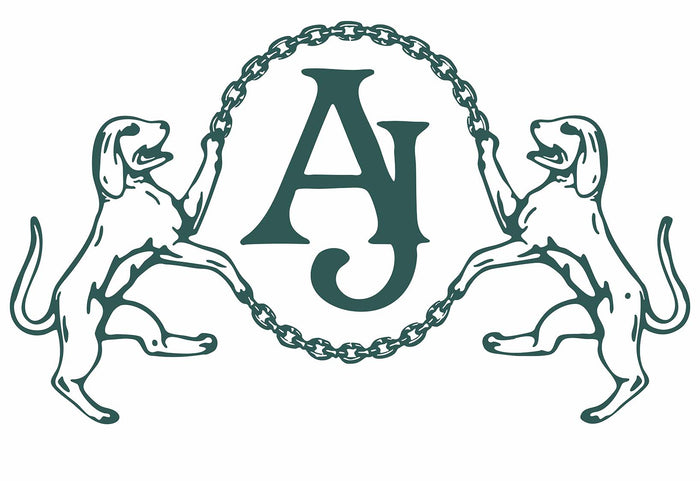Queen Victoria's wedding to Prince Albert on 10 February 1840 fundamentally transformed British wedding jewellery traditions, establishing customs that endure to this day. The young Queen's choice of orange blossom wreaths, her magnificent sapphire brooch, and the introduction of matching parures created a template for bridal jewellery that influenced generations of Victorian brides and continues to inspire modern royal weddings.
The Royal Wedding of 1840: A New Era in Bridal Jewellery

Queen Victoria's wedding ceremony at the Chapel Royal, St James's Palace, marked a departure from previous royal traditions. Sir George Hayter's celebrated painting of the marriage ceremony captures the Queen wearing her distinctive orange blossom wreath, though curiously omits one item of enormous sentimental significance: the large sapphire set in diamonds that Prince Albert had given her the day before their wedding.
The Times reporter observed that the Queen "wore no diamonds on her head, nothing but a simple wreath of orange blossoms... A pair of very large diamond earrings, a diamond necklace, and the insignia of the Order of the Garter, were the personal ornaments worn by Her Majesty." This deliberate simplicity in the Queen's headdress, eschewing the traditional jewelled coronet for natural flowers, established a new paradigm for royal and aristocratic brides.
The Wedding Brooch: A Symbol of Love

The Queen's wedding brooch, featuring a large sapphire surrounded by diamonds, measuring 3.7 x 4.1cm, became one of her most treasured possessions. Created in 1840 specifically for the wedding, this English-made piece exemplified the finest craftsmanship of the period. Victoria left the brooch to the Crown in her will, noting it was "an intensely personal memento" that she wore repeatedly throughout her life, often on wedding anniversaries along with her Honiton lace from the ceremony.
The Orange Blossom Tradition: From Fresh Flowers to Porcelain Parures
The orange blossom became the defining floral motif of Victorian wedding jewellery, a tradition that began with Victoria's wedding wreath and continued through Victorian royal brides right up to Queen Mary in 1893. The significance of orange blossom – symbolising purity, fertility, and eternal love – resonated deeply with Victorian sensibilities.
The Porcelain Orange Blossom Parure
Between 1839 and 1846, Prince Albert commissioned an extraordinary orange blossom parure in porcelain, gold, and enamel for Victoria. The suite included brooches and earrings, with the second brooch and earrings presented as a Christmas gift in 1845. The Queen's wedding wreath was perpetuated in a gold and porcelain circlet, the finest item in the suite, with blossoms studied from real flowering sprigs, received in 1846.
Victoria recorded in her Journal her delight at receiving these pieces: "My beloved one gave me a beautiful wreath in gold and porcelain orange flowers & buds with green and white enamel... made from nature & most beautifully done." The craftsmanship of these pieces, with their botanical accuracy and delicate enamelling, represented the pinnacle of Victorian decorative arts.
Garrard & Co.: Crown Jewellers to the Royal Wedding
R. & S. Garrard, established as Crown Jewellers, played a pivotal role in creating and maintaining Victoria's wedding jewellery and subsequent commemorative pieces. Their ledgers reveal fascinating details about royal commissions, from mounting Scottish pebbles in silver for modest sums like £2 10s to creating elaborate diamond parures.
Royal Commissions and Innovations
In 1858, Garrard's craftsmen were "cutting heart-shaped earrings from granite and mounting ditto in silver," charged to Prince Albert's account. The firm's versatility extended from working with precious diamonds to mounting deer's teeth as studs, brooches, earrings, and necklaces – reflecting the eclectic Victorian taste for sentimental jewellery that combined natural materials with precious metals.
The firm also created the fuchsia pendant and earrings in 1864, demonstrating their continued importance in royal commissions throughout Victoria's reign. Their work exemplified the technical innovations and artistic excellence that characterised Victorian jewellery at its finest.
Wedding Gifts and Royal Customs
The exchange of wedding jewellery gifts among the royal family and aristocracy established important social customs that filtered through Victorian society. Victoria's wedding generated a wealth of jewelled gifts that demonstrated both personal affection and political alliance.
The Train-Bearers' Brooches
Following the wedding ceremony, Queen Victoria presented her train-bearers with commemorative brooches in dark blue velvet cases. These pieces, preserved at Woburn Abbey and Hatfield House among other aristocratic collections, represent the tradition of royal favour expressed through jewellery. Each brooch served as a tangible reminder of participation in this historic occasion.
Family Gifts and German Influences
Prince Albert introduced several German commemorative jewellery traditions to the British court. The setting of infant teeth in precious ornaments, common in Germany at this date, appeared in pieces like the enamelled gold thistle brooch incorporating Princess Victoria's first tooth, shed in Scotland in 1847. The fuchsia pendant and earrings of 1864, set with milk teeth, continued this distinctly Germanic tradition of preserving family memories in jewellery.
The White Wedding Dress and Matching Jewellery
Victoria's choice of a white satin wedding dress, captured seven years later in Winterhalter's celebrated portrait of 1847, established white as the colour of choice for wedding gowns. The portrait shows the Queen in her wedding dress, Honiton lace, and jewels, painted as a gift for Prince Albert. As convention dictated for royal brides, Victoria's Honiton lace veil was thrown back to reveal her face, allowing the orange blossom wreath to be fully visible.
The Evolution of Bridal Fashion
The Queen's wedding ensemble influenced bridal fashion throughout the Victorian era and beyond. The combination of white dress, orange blossom ornaments, and carefully selected jewellery created a template that was widely emulated. Society columns of the period began recording costume and jewellery in minute detail, spreading awareness of royal fashion choices throughout the Empire.
Scottish Influences Through Prince Albert
Prince Albert's Scottish heritage and the couple's love for Scotland profoundly influenced Victorian wedding jewellery design. The Scottish connection proved particularly rich in commemorative jewels, with Victoria calling Balmoral "this dear Paradise."
Scottish Pebble Jewellery
The most ordinary pebbles found on the estate, when mounted as jewellery, acquired almost sacred status as tokens of royal favour. In 1848, a cairngorm picked up by the Prince at Lochnagar in September was set with enamelled gold, seed pearls, and rubies, creating one of the finest Scottish pieces in the royal collection. These items, dating from 1841 and 1842, came at the start of the Victorian mania for pebbles set in jewellery, before the acquisition of Balmoral opened the floodgates.
Masses of deer's teeth were mounted as studs, brooches, earrings, and necklaces, reflecting both Scottish sporting traditions and the Victorian fascination with natural materials in jewellery. This practice merged German commemorative traditions with Scottish materials, creating a unique hybrid style that became distinctively Victorian.
The Democratisation of Wedding Jewellery
Victoria and Albert's influence extended far beyond the court, leading the way in popularising jewellery and fashionable accessories at every level of society. When receiving a deputation from members of the Birmingham jewellery trade, Albert expressed astonishment at fashion's power to drive commerce, recognising the economic importance of the jewellery industry to British trade.
Commercial Innovation and Mass Production
The latest scientific and technical innovations were encouraged to benefit British trade. The promotion of commercial interests featured prominently in royal jewellery choices, reflecting the Queen's patriotic and serious approach to her role as sovereign of an advanced industrial nation. The Great Exhibition of 1851 showcased British jewellery craftsmanship to the world, with firms like Thornhill's displaying steel chatelaines featuring the conjoined initials V&A beneath a royal crown, blatantly affirming their claim to royal patronage.
Legacy and Lasting Influence
The jewellery traditions established at Victoria's wedding continued throughout her reign and beyond. Orange blossom wreaths and trimmings were worn by Victorian royal brides for over half a century, establishing a tradition that influenced wedding customs globally. The emphasis on sentimental value over mere ostentation, the incorporation of natural materials, and the creation of commemorative pieces for wedding participants all became standard practices.
From Wedding to Widowhood
With Prince Albert's death in December 1861, the character of royal jewel gifts changed dramatically. The daughters were furnished with trousseaux incorporating memorial elements, while granddaughters received memorial pendants featuring their unknown grandfather. The transformation from celebratory wedding jewellery to mourning pieces marked a profound shift in Victorian jewellery culture, yet the foundational importance of the 1840 wedding jewellery remained paramount in the Queen's memory and the nation's consciousness.
Specialised Reference Guides
Orange Blossom Parures and Floral Wedding Jewellery
Comprehensive exploration of the orange blossom tradition in Victorian wedding jewellery, from Queen Victoria's pioneering wreath to the elaborate porcelain and gold parures created by master craftsmen. Discover how this floral motif became synonymous with bridal purity and how Victorian jewellers translated natural forms into enduring works of art through innovative techniques in porcelain, enamel, and precious metals.
Garrard & Co.: Royal Wedding Jewellers
Detailed examination of R. & S. Garrard's role as Crown Jewellers, documenting their wedding commissions from Victoria's reign through to Queen Mary. Explore archival records revealing the creation process, costs, and craftsmanship behind iconic royal wedding jewels, including the techniques used to mount everything from diamonds to Scottish cairngorms and deer teeth.
Scottish Influences in Victorian Wedding Jewellery
In-depth study of how Prince Albert's German heritage merged with Scottish traditions to create a unique Victorian wedding jewellery style. From Balmoral pebbles to Highland motifs, discover how Scottish materials and symbolism became integral to royal wedding gifts and commemorative pieces, establishing traditions that spread throughout Victorian society.
Victorian Wedding Gift Jewellery and Commemorative Pieces
Comprehensive guide to the elaborate gift-giving customs surrounding Victorian weddings, from train-bearers' brooches to family heirlooms. Learn how wedding jewellery gifts functioned as social currency, political statements, and personal mementos, with detailed analysis of surviving pieces in aristocratic collections.
Sentimental and Memorial Elements in Wedding Jewellery
Exploration of the deeply personal aspects of Victorian wedding jewellery, including the incorporation of hair, teeth, photographs, and miniatures. Understand how German commemorative traditions influenced British customs and how wedding jewellery evolved to incorporate memorial elements, particularly after Prince Albert's death in 1861.
Using This Reference Collection
This comprehensive reference collection on Victorian Royal Wedding Jewellery provides scholars, collectors, and enthusiasts with detailed insights into one of the most influential periods in jewellery history. Each specialised guide offers in-depth analysis of specific aspects, from technical craftsmanship to social significance, supported by primary source material from the Royal Archives and contemporary accounts. Whether researching specific pieces, understanding historical context, or identifying authentic Victorian wedding jewellery, these resources offer authoritative guidance based on extensive documentation and surviving examples in museum and private collections.


